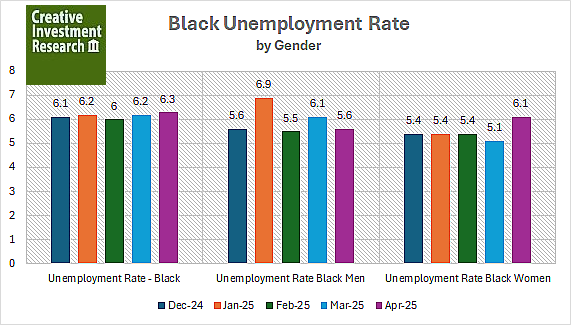Analysis of Black Employment and Unemployment – April 2025
Summary & Overview
The April 2025 data reveals a troubling trend for the Black labor force, particularly Black women, who saw a sharp increase in unemployment. Overall, while the Black civilian labor force size remained relatively stable, the number of employed individuals declined by 36,000, and the number of unemployed rose by 29,000. The Black unemployment rate ticked up to 6.3%, continuing a persistent rise from earlier in the year.
1. Black Women, 20 Years and Over
Unemployment increased by 106,000 the largest rise of any subgroup
Unemployment rate surged from 5.1% to 6.1%, a full 1 percentage point increase, outpacing men and youth.
Employment dropped by 38,000, despite an increase in labor force participation (+68,000).
This suggests that new entrants to the labor force are not finding jobs, exacerbating joblessness for Black women.
2. Black Men, 20 Years and Over
Employment increased (+48,000), and unemployment declined (-55,000).
Unemployment rate fell from 6.1% to 5.6%.
This segment fared better than others, indicating possible hiring in traditionally male-dominated sectors (e.g., construction, warehousing, transportation).
3. Black Youth (16 to 19 Years)
Labor force participation dropped (-68,000), and employment fell (-45,000).
Unemployment fell (-23,000), but the overall unemployment rate remains extremely high at 19.6%.
This is concerning ahead of the summer hiring season.
Likely Causes Behind Black Women’s Unemployment Spike
4. Industries Affected
A. Retail and Hospitality:
These sectors typically employ a high share of Black women.
Layoffs or reduced hours post-holiday season may have a delayed impact in Q2.
B. Healthcare Support Roles:
Often seen as stable, but recent reimbursement rate changes, union disruptions, or burnout may be contributing to layoffs.
C. Education and Childcare:
Budget cuts and staffing shifts in school districts or daycare centers could be reducing demand for support staff and teachers.
5. Geographic Hotspots
Based on past trends and industry exposure, the following regions may be facing heightened impacts:
A. Georgia (especially Atlanta): Large Black population, high share in retail and health sectors.
B. Illinois (especially Chicago): Ongoing school and public sector cuts may be affecting female-dominated jobs.
C. Texas (Dallas, Houston): Mixed job growth; potential decline in lower-wage services.
D. New York (NYC): High cost of living combined with layoffs in healthcare and education.
E. California (Los Angeles, Oakland): Women of color in caregiving and administrative roles are often the first to lose jobs during public budget adjustments.
6. Policy Implications and Recommendations
A. Targeted Workforce Support:
Launch Black women-focused job training and re-entry programs, especially in healthcare tech, renewable energy, and skilled trades.
B. Childcare Support Subsidies:
Bolster access to affordable childcare to reduce barriers for workforce reentry.
C. Place-Based Investments:
Focused crowdfunding, community investment, state and local small business investment and lending stimulus or grants in cities with high unemployment surges among Black women (Atlanta, Chicago, LA).


